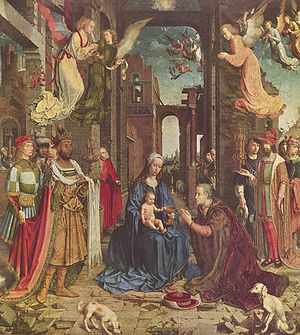
Antwerp Mannerism
Encyclopedia

Mannerism
Mannerism is a period of European art that emerged from the later years of the Italian High Renaissance around 1520. It lasted until about 1580 in Italy, when a more Baroque style began to replace it, but Northern Mannerism continued into the early 17th century throughout much of Europe...
, but the name suggests a peculiarity that was a reaction to the "classic" style of the earlier Flemish painters
Early Netherlandish painting
Early Netherlandish painting refers to the work of artists active in the Low Countries during the 15th- and early 16th-century Northern renaissance, especially in the flourishing Burgundian cities of Bruges and Ghent...
. Although attempts have been made to identify the individual artists, most of the paintings remain attributed to anonymous masters
Anonymous masters
In the history of art and architecture, an anonymous master is an architect, Old Master painter, or printmaker whose work is known, but whose name is not.-Pre-Renaissance:...
. Characteristic of Antwerp Mannerism are works attributed to Jan de Beer, those of the Master of 1518
Master of 1518
The Master of 1518 is a Flemish painter belonging to the stylistic school of Antwerp Mannerism. A group of unsigned paintings is attributed to this artist on stylistic grounds, and his name is derived from the date inscribed on the painted wings of a carved wooden altarpiece of the Life of the...
(possibly Jan Mertens or Jan van Dornicke
Jan van Dornicke
Jan van Dornicke was a South Netherlandish painter who was born about 1470 and died about 1527. His first name is sometimes spelled “Janssone”, and his last name is sometimes spelled “van Doornik” or “van Dornick”. He was active in Antwerp from about 1509 to about 1525. His paintings are...
), and some early paintings of Jan Gossaert and Adriaen Isenbrandt. The paintings combine Early Netherlandish
Early Netherlandish painting
Early Netherlandish painting refers to the work of artists active in the Low Countries during the 15th- and early 16th-century Northern renaissance, especially in the flourishing Burgundian cities of Bruges and Ghent...
and Northern Renaissance
Northern Renaissance
The Northern Renaissance is the term used to describe the Renaissance in northern Europe, or more broadly in Europe outside Italy. Before 1450 Italian Renaissance humanism had little influence outside Italy. From the late 15th century the ideas spread around Europe...
styles, and incorporate both Flemish and Italian traditions into the same compositions. Practitioners of the style frequently painted subjects such as the Adoration of the Magi and the Nativity
Nativity of Jesus in art
The Nativity of Jesus has been a major subject of Christian art since the 4th century. The artistic depictions of the Nativity or birth of Jesus, celebrated at Christmas, are based on the narratives in the Bible, in the Gospels of Matthew and Luke, and further elaborated by written, oral and...
, both of which are generally represented as night scenes, crowded with figures and dramatically illuminated. The Adoration scenes were especially popular with the Antwerp Mannerists, who delighted in the patterns of the elaborate clothes worn by the Magi and the ornamentation of the architectural ruins in which the scene was set.
The next wave of influence from Italian painting came with Romanism
Romanism (painting)
Romanism was the style of painting of a group of artists in the late 15th and early 16th century from the Netherlands who began to visit Italy and started to incorporate Renaissance influences in their work. The greatest artist in the style was Jan Mabuse...
, as seen in the later works of Gossaert.
Other, architectural, meaning
Confusingly, Antwerp Mannerism may also be used to describe the style of architecture, which is loosely Mannerist, developed in Antwerp by about 1540, which was then influential all over Northern Europe, for example on Elizabethan architectureElizabethan architecture
Elizabethan architecture is the term given to early Renaissance architecture in England, during the reign of Queen Elizabeth I. Historically, the period corresponds to the Cinquecento in Italy, the Early Renaissance in France, and the Plateresque style in Spain...
.

